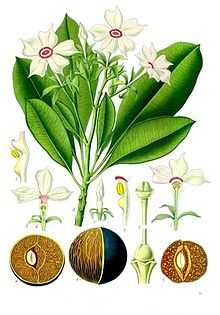Cerbera odollam
| Suicide tree | |
|---|---|
 | |
| Leaves, flowers and seeds of C. odollam From Koehler's Medicinal-Plants 1887 | |
| Scientific classification | |
| Kingdom: | Plantae |
| (unranked): | Angiosperms |
| (unranked): | Eudicots |
| (unranked): | Asterids |
| Order: | Gentianales |
| Family: | Apocynaceae |
| Genus: | Cerbera |
| Species: | C. odollam |
| Binomial name | |
| Cerbera odollam Gaertn. | |
Cerbera odollam, commonly known as the Suicide tree, Pong-pong, and Othalanga, is a species of tree native to India and other parts of Southern Asia. It grows preferentially in coastal salt swamps and in marshy areas. It grows wild along the coast in many parts of Kerala, India and has been grown as a hedge between home compounds. It yields a potent poison, often used for suicide or murder.[1]
Description
The fruit, when still green, looks like a small mango, with a green fibrous shell enclosing an ovoid kernel measuring approximately 2 cm × 1.5 cm and consisting of two cross-matching white fleshy halves. On exposure to air, the white kernel turns violet, then dark grey, and ultimately brown, or black. The plant as a whole yields a milky, white latex. Cerbera odollam bears a close resemblance to the Oleander bush, another highly toxic plant from the same family.
Leaves are terminally crowded, with tapering base, acuminate apex, and entire margin. Trunk with branchlets whorled.
Common names
Cerbera odollam tree is known by a number of vernacular names depending on the region. These are: othalanga maram in the Malayalam language used in Kerala, India; kattu arali in the adjacent state of Tamil Nadu; famentana, kisopo, samanta or tangena in Madagascar; and pong-pong, buta-buta, bintaro or nyan in southeast Asia.[2]
In Sri Lanka, it is known as "ගොන් කදුරු - gon kaduru" in Sinhala.
Toxicity

The kernels of C. odollam contain cerberin, a potent alkaloid toxin related to digoxin, a poison found in foxglove. The poison blocks the calcium ion channels in heart muscle, causing disruption of the heart beat. This is most often fatal. Cerberin is difficult to detect in autopsies and its taste can be masked with strong spices. Therefore it is often used in homicide and suicide in India. In 2004, a team led by Yvan Gaillard of the Laboratory of Analytical Toxicology in La Voulte-sur-Rhône, France documented more than 500 cases of fatal Cerbera poisoning between 1989 and 1999 in the south-west Indian state of Kerala alone.[3]
The seeds also have a long history as a poison in Madagascar. The poison was responsible for the death of 2% of the population (3000 people per year, 50,000 per generation) of the central province of Madagascar. The belief in the genuineness and accuracy of trial by ordeal using this poison was so strongly held among all, that innocent people suspected of an offense did not hesitate to subject themselves to it; some even showed eagerness to subject themselves to the test. On one occasion over 6000 people died in a single ordeal. The use of ritual poison in Madagascar was abolished in 1861 by King Radama II.[4] However, it is believed that this practice may still occur in remote areas of the island.
Uses
The fruits are used for manufacturing bioinsecticides and deodorants.
Investigations have also been made into the feasibility of converting the seeds into biodiesel.[5]
References
| Wikimedia Commons has media related to Cerbera odollam. |
- ↑ 'Suicide tree' toxin is 'perfect' murder weapon - 26 November 2004 - New Scientist
- ↑ Gaillard Y, Krishnamoorthy A, Bevalot F. Cerbera odollam: a 'suicide tree' and cause of death in the state of Kerala, India. J Ethnopharmacol. 2004 Dec;95(2-3):123-6.
- ↑ 'Suicide tree' toxin is 'perfect' murder weapon - 26 November 2004 - New Scientist
- ↑ De Maleissye, J., 1991. In: Bourin, F. (Ed.), Histoire du poison. Paris.
- ↑ Cerbera odollam (sea mango) oil as a promising non-edible feedstock for biodiesel production